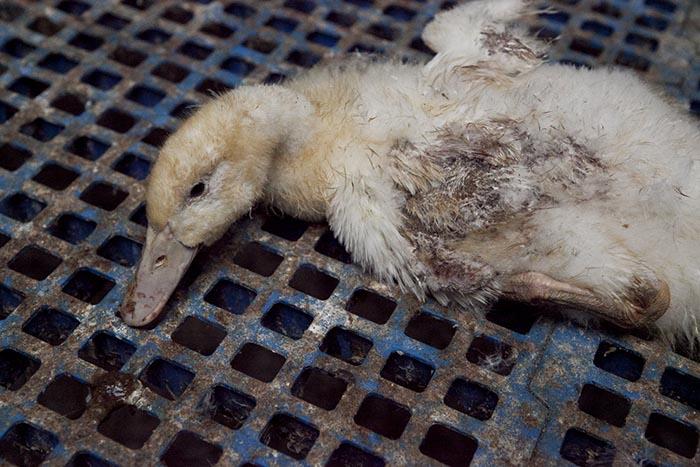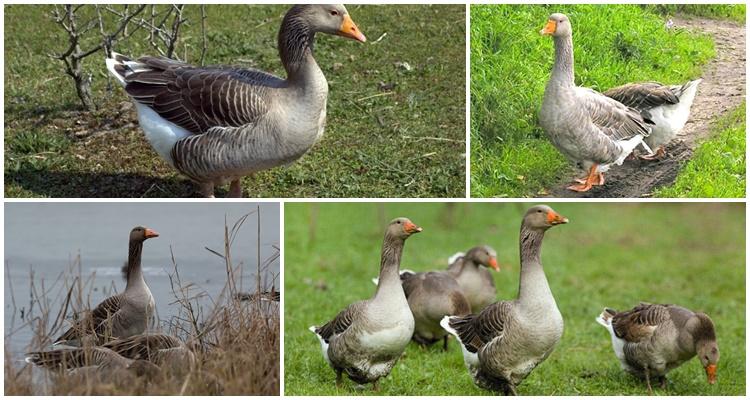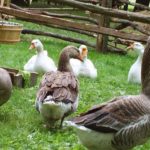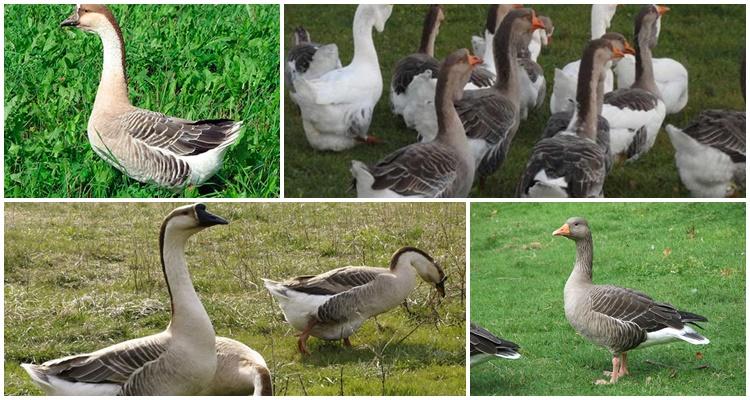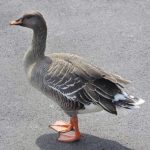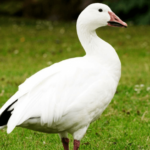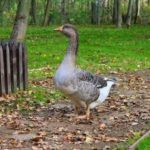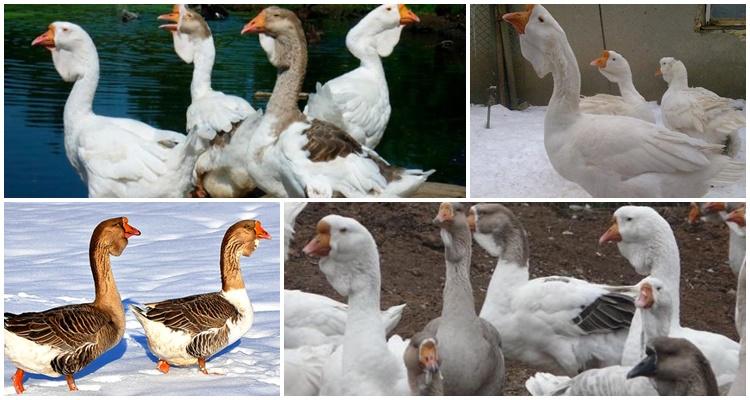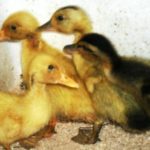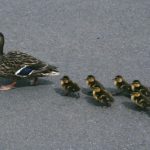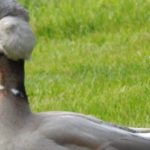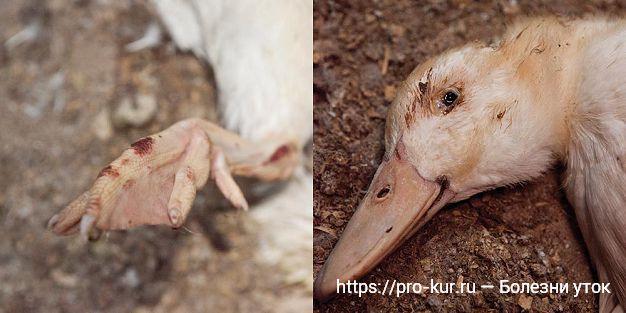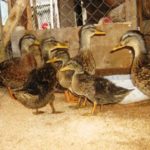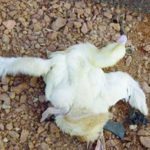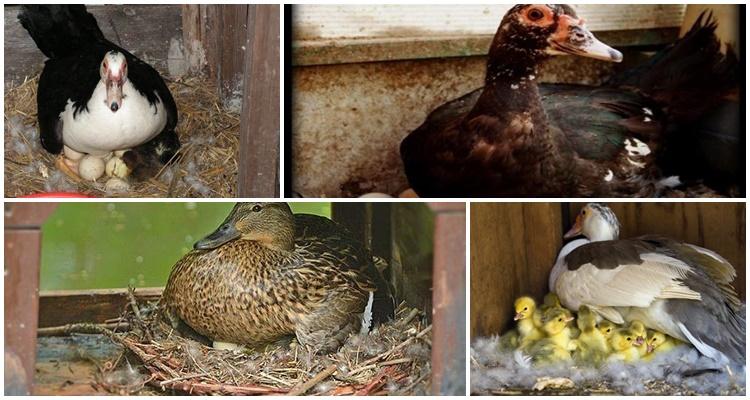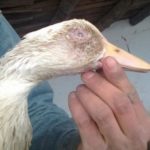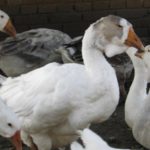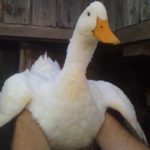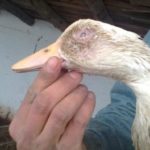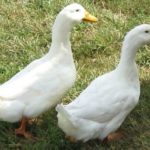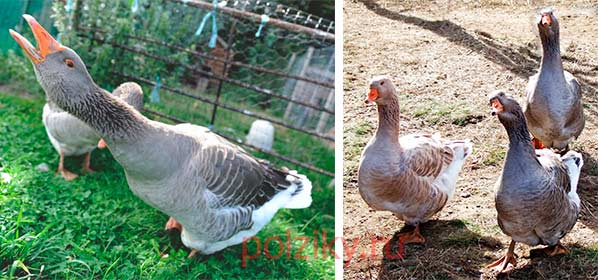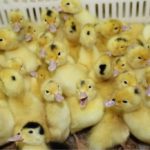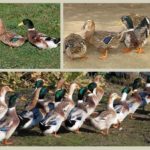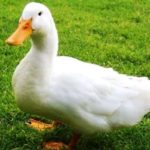An important aspect of poultry breeding is proper nutrition and favorable living conditions. Deviations from hygiene standards, poor diet and lack of exercise lead to the spread of diseases in ducks of domestic, foreign breeds and mulards. There are infectious, non-infectious and parasitic diseases. Some bacterial infections are transmitted to humans, and mass mortality of birds will ruin the breeder.
- Infectious diseases and methods of their treatment
- Aspergillosis
- Pasteurellosis (cholera)
- Tuberculosis
- Bacillary white diarrhea (pullorosis)
- Contagious runny nose
- Viral hepatitis of ducklings
- Typhus
- Coccidiosis
- Viral enteritis (duck plague)
- Colibacillosis
- Salmonellosis (paratyphoid)
- Non-communicable diseases and rules for combating them
- Vitamin deficiencies
- Goiter diseases
- Pica
- Esophageal blockage
- Yolk peritonitis
- Inflammation of the cloaca (cloacitis)
- Oviduct prolapse
- Inflammation of the genital organs
- Inflammation of the oviduct
- Cannibalism
- Lack of plumage
- Ammonia blindness
- Conjunctivitis
- Parasitic diseases and methods of getting rid of them
- Echinostomatiasis
- Worms
- External parasites
Infectious diseases and methods of their treatment
Most duck diseases caused by infection develop quickly and result in the death of the birds.
Aspergillosis
Newborn ducklings die from a fungal disease of the respiratory tract. Adult ducks tolerate the disease easily.
Symptoms:
- the duckling does not eat or drink;
- the mucous membrane of the eyes is inflamed;
- hoarse breathing.
An adult bird breathes heavily and pulls its head forward. The fungus cannot be treated, but its spread can be avoided by adding the antifungal drug Nystatin to the food and copper sulfate to the water.
Pasteurellosis (cholera)
When the disease occurs, the mucous membranes of the organs become inflamed. The intestinal tissues die first, then the liver and heart.
Sources of infection:
- carriers are recovered ducks, pigs and cows;
- carriers are rodents;
- water;
- tick bite.
Symptoms of the disease:
- sharp heat;
- poor coordination of movements;
- foaming from the nose and eyes;
- thirst.
Treatment of cholera at home is impossible. The disease develops rapidly within two hours. Pasteurellosis is rare, but to prevent its spread, infected individuals must be destroyed.
Tuberculosis
An infection that is dangerous to humans may not cause symptoms for two months. The maximum incubation period is 12 months.
Signs:
- reduction or cessation of egg production;
- formation of nodules and seals on the skin and feet;
- lameness.
The disease affects the intestines and liver. As a result, the ducks suffer from diarrhea and jaundice and refuse to eat. Tuberculosis cannot be cured. Infected carcasses and eggs are destroyed.
Bacillary white diarrhea (pullorosis)
The disease develops as a result of infection with salmonella.
Symptoms:
- white droppings that look like foam;
- apathy;
- rapid breathing.
Hatched ducklings die within three days. Pullorosis is an incurable disease.
Contagious runny nose
The seasonal disease occurs in the fall. Ducklings often suffer from a runny nose. The behavior and well-being of ducks does not change. They actively move and eat, but sneeze. A pale solution of manganese is instilled into the nose of birds.
Viral hepatitis of ducklings
Infectious liver damage causes symptoms characteristic of Indian ducks:
- drowsiness;
- drooping head and wings;
- labored breathing.
In newborn ducklings, the disease quickly ends in convulsions and death; treatment does not produce results.
Typhus
An incurable disease is manifested by the following symptoms:
- loss of appetite;
- weight loss;
- coordination of movements is impaired;
- the droppings become liquid and yellow-green in color.
Typhus affects adult ducks. At the first sign, the birds are slaughtered.
Coccidiosis
The disease is caused by coccidia bacteria that infect the intestines of mulard ducks.
Symptoms:
- poor appetite;
- green feces;
- immobility;
- ruffled feathers.
The duck sits, ruffled, and trembles from the cold even in the warmth of the room.
Antibiotics are used for treatment:
- "Amprolium";
- "Zoalen";
- "Bycox."
20 percent of sick birds die in the first week. In other ducks, the disease becomes chronic.
Viral enteritis (duck plague)
An acute disease with high mortality among adult ducks and ducklings develops 10 days after contact with a carrier or consumption of contaminated water or food. Carriers of infectious agents are rats, ticks, mosquitoes.
Symptoms:
- lethargy;
- lack of appetite;
- diarrhea;
- drooping wings;
- lowered head;
- lacrimation;
- mucous discharge from the nose.
The peculiarity of duck plague is that after the acute period the condition improves and the symptoms disappear. But then the bird begins to have convulsions and dies. Enteritis is an incurable disease.
Colibacillosis
Signs of infection:
- thirst;
- refusal of food;
- blue beak;
- liquid droppings.
The causative agent of the disease, E. coli, causes changes in internal organs, which are detected after autopsy:
- pericarditis;
- greening of the liver;
- inflammation and enlargement of tissue around the eye sockets;
- damage to the upper respiratory tract.
Bacteria from the environment enter the eggs through the shell. Through droppings and dirt, ducklings aged from three to fourteen days become infected and die in thirty percent of cases. To treat adult birds, complex antibacterial drugs with levofloxacin and enrofloxacin are used.
Salmonellosis (paratyphoid)
The causative agent of the disease, salmonella, enters the body of birds with food, is transmitted from sick relatives and gets into the eggs.
There are two forms of the disease:
- acute - characteristic of ducklings, they hatch already infected from the eggs of a sick duck, turn over and quickly die from convulsions;
- chronic - characteristic of adult birds.
Symptoms of paratyphoid:
- temperature increase;
- weakness;
- unsteady gait;
- conjunctivitis;
- diarrhea.
A sick bird looks untidy due to matted feathers on the face and around the cloaca.It is difficult for the duck to move, so most of the time it sits with its wings down. With progressive salmonellosis, the bird refuses to eat and throws its head back. At the last stage of the disease, convulsions begin, ducks and ducklings fall on their backs.
Treatment with antibiotics is effective at the first symptoms. Along with the feed, ducks are given Tetracycline or Biomycin. Dead birds are burned to avoid further infection of the livestock. Salmonellosis is dangerous to humans and is transmitted by contact with an infected duck or eating raw duck eggs.
Non-communicable diseases and rules for combating them
Pathological conditions arise as a result of improper feeding, maintenance in unfavorable conditions and are accompanied by aggression of birds.
Vitamin deficiencies
Ducks suffer from three types of vitamin deficiency:
| Missing vitamin | Symptoms |
| A | Stunted growth in ducklings. Redness of the mucous membranes of the eyes. Pallor of legs and beak. Reduced egg production in adult ducks |
| IN | Convulsions |
| D | Rickets |
Early treatment:
- adding foods rich in missing vitamins to the diet;
- feeding mineral supplements - fish oil, crushed shells, bone meal;
- walking birds in the fresh air.
Advanced conditions are intensively treated with vitamin preparations.
Goiter diseases
Pathologies include catarrh - bloating caused by stagnation of poorly chopped, coarse grass. As a result, the birds cannot eat and wheeze.
Signs of the disease:
- the duck opens its mouth;
- nasal discharge with an unpleasant odor.
If ducks breathe with their beaks open, you need to feel their crop. In catarrh it remains soft. The plug is cleaned by injecting a 0.5 percent solution of hydrochloric acid or vegetable oil into the esophagus. The duck is also given a massage—the throat is stroked from top to bottom.
Pica
Ducks eat rocks, sawdust and any inedible object in sight. Eating disorders are caused by a monotonous diet of plants. Bone meal and dairy products should be added to the birds' diet.
Esophageal blockage
Symptoms:
- refusal of food and water;
- depressed state;
- lump in the throat area.
If the esophagus is blocked by a foreign object, the goiter will be hard. The condition is dangerous for the bird due to exhaustion. A swallowed object can only be removed surgically.
Yolk peritonitis
An incurable disease has no clear symptoms. Lack of appetite is observed in both infectious and non-infectious diseases. The clumping of feathers around the cloaca is also characteristic of cloacitis, which accompanies vitamin deficiency. When the intestines become inflamed, ducks stop laying eggs, become exhausted and die within a week.
Peritonitis develops with poor nutrition. To avoid losses, ducks need to be given balanced plant food and solid particles to digest coarse fibers.
Inflammation of the cloaca (cloacitis)
Symptoms of the disease:
- redness of the mucous membrane;
- purulent discharge;
- film formation.
Cloacitis develops due to a lack of vitamins A and D.
Treatment:
- cleanse the cloaca of pus;
- treat with hydrogen peroxide or iodine;
- apply antibiotics externally - penicillin, streptomycin ointment.
You need to add carrots, crushed shells, more herbs to the birds’ diet, and also let them swim in a pond.
Oviduct prolapse
Causes:
- release of a large egg;
- inflammation;
- diarrhea;
- constipation.
The oviduct must be straightened, having previously been disinfected with a solution of potassium alum or manganese and lubricated with petroleum jelly.Oviduct prolapse may recur or be accompanied by salpinigitis, a deviation of oviposition in which ducks lay deformed eggs without shells or yolks. If young animals become ill, the birds will have to be slaughtered, since egg production does not return to normal with age.
Inflammation of the genital organs
The condition occurs in drakes if the ducks did not mate in water.
How to treat:
- rinse the cloaca;
- treat with anti-inflammatory agents.
To prevent inflammation, it is necessary to provide birds with access to a pond during the mating period.
Inflammation of the oviduct
Pathology occurs in productive ducks for unknown reasons, probably after the release of large eggs.
Signs:
- eggs are covered with mucus;
- curdled discharge;
- inflammation, protrusion of the oviduct into the cloaca.
Birds lose weight, and ducklings appear weaker. Since the cause of the disease has not been established, there is no cure for ducks.
Cannibalism
The reason for the aggressive behavior of ducks is vitamin deficiency, lack of walking, unsanitary conditions, lack of air and light in the duckling coop. Birds attack weaker relatives and ducklings.
To correct the situation, the aggressive individual is transferred to a separate room. Vitamin supplements, carrots, alfalfa are introduced into the diet, and access to water for swimming is also provided. If the bird's condition does not improve, it is sent for slaughter.
Lack of plumage
Birds lose feathers and become aggressive due to a lack of protein, vitamins, unsanitary living conditions in a stuffy room and lack of dry bedding. The condition is combated with the help of vitamin supplements, walking, and correcting maintenance errors. Bald ducks are removed separately. Particularly aggressive birds are eliminated.
Ammonia blindness
Inflammation of the mucous membranes of the eyes develops in ducklings in the second month of life due to a lack of vitamin A and being kept in an unventilated area. The eyes become red and swollen. The birds move little, eat poorly and gradually become blind. Their condition will be alleviated by carrots, fish oil in the diet and walks in the fresh air.
Conjunctivitis
Ducklings after hatching and adult birds have foam in their eyes during cold seasons. Ducks are active, but whitish formations deprive them of their vision.
Treatment of the disease:
- rinse your eyes with strong green tea or furatsilin solution;
- Place tetracycline ointment under the eyelid or apply any anti-inflammatory eye drops.
It is better to keep sick ducklings away during treatment, since conjunctivitis can be a manifestation of hepatitis.
Parasitic diseases and methods of getting rid of them
Helminth infection is difficult to recognize due to mild symptoms. Ducks with reduced immunity and ducklings are susceptible to parasitic infections. Often the presence of worms in the body is accompanied by other diseases. Sometimes the root cause of ailments is revealed after the slaughter of the bird. Sarcocystosis is transmitted to humans from birds, in which the parasites penetrate the muscles.
Echinostomatiasis
The infection is accompanied by diarrhea, depression and weight loss. The cause of the disease is flukes in the intestines. Infected birds are isolated from healthy birds for three days and treated with Phenasal and Betinol.
Worms
Symptoms of infection:
- sudden weight loss;
- decreased egg production;
- worms in the droppings.
Treatment:
- use of anthelmintic drugs;
- add onions, garlic, chopped pine needles to the feed.
The duckling is cleaned of droppings and treated with a 5% solution of Xylophanal-5.Duck infected with helminths should not be eaten. The bodies of sick individuals must be burned.
External parasites
Ducks pick up skin parasites from wild or domestic animals:
- lice;
- lice eaters;
- fleas
Insects feed on blood, causing itching and feather loss.
How to cure ducks:
- treat feathers with Butox-50, preparations with sulfur and mercury;
- put sand baths for bathing.
The duckling house is disinfected with karbofos. To prevent diseases, you need to carry out general cleaning of the premises every month.

